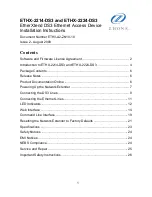
Chapter 6
Digital I/O
©
National Instruments Corporation
6-9
The Change Detection Event signal also can be used to detect changes on
digital output events.
DI Change Detection Applications for Non-Isolated
Devices
(NI 6124 Only)
The DIO change detection circuitry can interrupt a user
program when one of several DIO signals changes state.
You also can use the output of the DIO change detection circuitry to trigger
a DI or counter acquisition on the logical OR of several digital signals. To
trigger on a single digital signal, refer to the
. By routing the Change Detection
Event signal to a counter, you also can capture the relative time between
samples.
You also can use the Change Detection Event signal to trigger DO or
counter generations.
Connecting Digital I/O Signals on Non-Isolated Devices
(NI 6124 Only)
The DIO signals, P0.<0..7>, PFI <0..7>/P1.<0..7>, and
PFI <8..15>/P2.<0..7> are referenced to D GND. You can individually
program each line as an input or output. Figure 6-4 shows
PFI <0..3>/P1.<0..3> configured for digital input and PFI <4..7>/P1.<4..7>
configured for digital output. Digital input applications include receiving
TTL signals and sensing external device states, such as the state of the
switch shown in the figure. Digital output applications include sending
TTL signals and driving external devices, such as the LED shown in the
figure.
















































